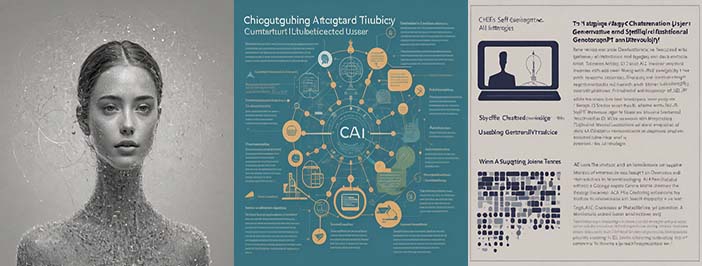Interfacing Chat GPT: A Heuristic Approach for Improving Generative AI Literacies
Desiree Dighton East Carolina University

Introduction
In “Politics of the Interface” (1994), Selfe and Selfe imagined a future in which writing technologies would be shaped by computers and writing research. As our field developed alongside the evolution of personal computing, we’ve adapted writing theory, practice, pedagogy, and research to significant social and technological transitions. Throughout, we’ve kept our commitment to student agency. To scaffold students making key choices about how they position themselves as writers in school, professional, and social contexts, we emphasize flexible, individualized processes of brainstorming, conducting preliminary research, drafting, sharing their writing with others, reflecting on that feedback, revising, citing research, and more. We’ve spent decades convincing our students that the process they go through to generate a text is as valuable as and is inseparable from the end goal of their written products. Over the years, we’ve advocated for more inclusive writing and assessment practices and standards that take seriously student writing processes and their written products as academic writing with value. We’ve moved writing rubrics away from a ‘Standard’ Written English and toward honoring students’ home languages and linguistic diversity. As a field, we’ve largely embraced technologies as tools and avenues to expand the potentials for student agency in writing their personal and professional futures. Many of us have quickly adapted our pedagogies and assignments to link technologies and student writing, viewing these pivots as a necessary to help students fulfill professional and personal goals.
Early on, Selfe & Selfe (1994) observed that computer interfaces act as “linguistic and cultural contact zones,” a borderland that can be particularly harmful to “the perspective of the non-dominant groups in our culture” (p. 485). These interfaces, however, are the borders that must be crossed to access the computer’s infrastructure and processes for our varied human purposes (Grabill, 2003). Stanfill (2015) described interface design as providing “paths of least resistance” that users should take to the interface design and the information behind it. Even as interfaces provide routes to greater technological and information access, they also become frames we look through, so much that interfaces lose their visibility to users (Jones, 2021; Selfe & Selfe, 1994; Stanfill, 2015). Contrary to being neutral and transparent, interfaces contain and circulate not only information but the dominant “values of our culture—ideological, political, economic, educational” (p. 485). To “unconceal” (Selfe & Selfe, 1994, p. 501) the dominant values in our present era of “Generative AI” technologies like ChatGPT, we can engage our classrooms in building Critical AI Literacies through interface heuristic development and analysis. By doing so, we situate interfaces in their material specificity, identifying “the point of contact between two elements that interact” (Jones, 2021, p. 1) and the “complex set of material relations among culture, technology, and technology users” (Selfe and Selfe, 1994, p. 485). Such heuristic interface work will also construct and practice Critical AI literacies—the next great turn for the field of writing studies.
Over time, technology has become inseparable from how most of us orient to writing. In our research, we’ve translated and transformed literacy and writing concepts from print to digital (Gee, 2004; Hawisher & Selfe, 2000; Selber, 2004; Selfe, C., 1999; Yancy, 2003). Generative writing technologies like ChatGPT increase the urgency to impart more complex digital literacies that address “the nature, capacities, and risks of AI tools” and their use (MLA-CCCC Joint Task Force on Writing and AI). And yet, how do we develop critical analytics for better understanding and interacting with complex, black-boxed technologies like ChatGPT? We can begin with the materiality of its interface. As others have before us, we can ask what options—the affordances and constraints—have been included or removed from other common interfaces in the interface design for ChatGPT? How does the interface direct our attention and interaction with the infrastructure behind it—the language models and artificial intelligence technologies generating the response? While many contributors to this collection will offer meaningful recommendations for ChatGPT collaborations, this chapter will offer heuristic development and analysis at the level of interface. The next section highlights theories and practices of interface design and analysis as the foundation for heuristic approaches to building Critical AI Literacies with ChatGPT.
The recent widespread public access of generative AI “writing” technologies like ChatGPT depended upon its interface design. ChatGPT’s interface has taken a subtle but significant functional turn: it primarily relies on the real-time input of language phrases by its users, rather than pre-programmed and designed features like tool bars, drop down menus, and various buttons. The chat-based interface might not look new to us—we encounter “helpful” chat bots when we seek customer service on many websites, for instance—but ChatGPT is made of better stock than other chat bots, or so we’re told. Petabytes of data and advanced natural language technologies create the illusion of “human-like” learning and interaction when interfacing with the tool.


It’s the “human-like” characteristics ascribed to and performed by ChatGPT, along the “world-making” power of its rhetorical circulation (Jones, 2021; Gries & Brooke, 2018) that, ultimately, might prove more influential in transforming our educational and writing landscapes than any of its complex technologies alone.






